Key takeaways
- Technology in education reshapes interactions with knowledge, providing accessibility and fostering broader discussions, particularly in philosophy.
- While digital tools enhance learning experiences, they can detract from deep focus and nuanced communication essential to philosophical inquiry.
- Effective integration of technology requires a balance between traditional methods and digital resources to enrich understanding rather than overwhelm it.
- The impact of technology on learning is significantly influenced by thoughtful application, promoting critical thinking while navigating potential distractions.
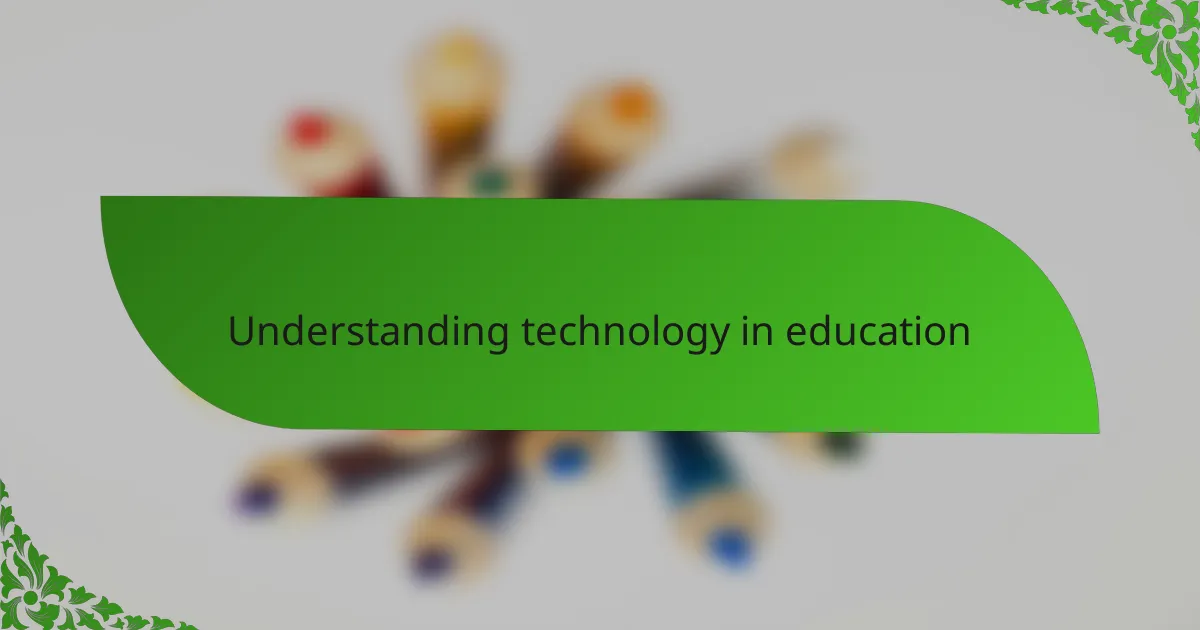
Understanding technology in education
When I first saw computers being introduced in my philosophy classes, I was both curious and skeptical. How could a screen replace the lively debates and deep reflections we used to have? Technology in education isn’t just about gadgets; it’s about reshaping how we interact with knowledge and each other.
I’ve noticed that tools like online forums and digital libraries make philosophical texts more accessible than ever. But do these conveniences sometimes dilute the depth of understanding? It makes me wonder if technology serves as a bridge or a barrier in truly grasping complex ideas.
Ultimately, understanding technology in education means recognizing it as a dynamic partner rather than a passive tool. It challenges our traditional methods, pushing us to rethink how we teach and learn philosophy. Have you experienced moments when technology unexpectedly deepened your insight? I certainly have, and those moments stick with me.
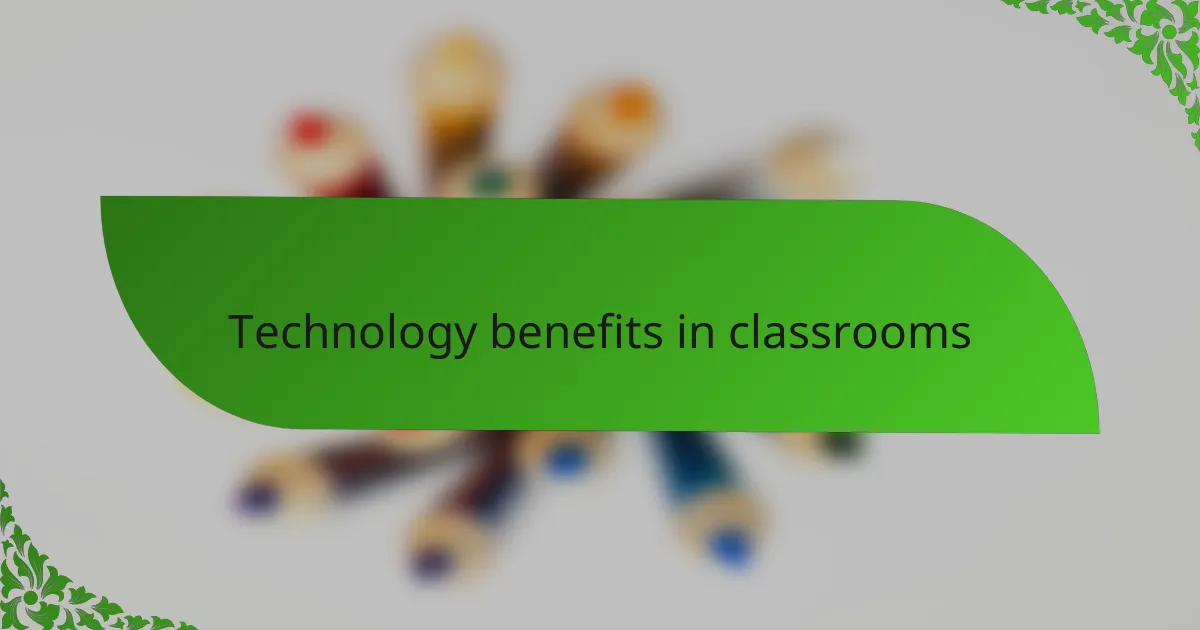
Technology benefits in classrooms
One of the benefits I’ve experienced firsthand is how technology opens up access to a vast range of philosophical works that were once locked away in dusty shelves. Suddenly, a rare manuscript or a lesser-known essay is just a click away, which feels like discovering a hidden door in a familiar house. Have you ever found yourself diving deep into ideas simply because they were easier to reach?
Another advantage lies in the interactive nature of digital platforms. Online discussions and collaborative tools allow me to engage with diverse viewpoints beyond the immediate classroom, enriching the dialogue in ways I hadn’t anticipated. It makes me realize how technology can broaden the circle of philosophical exchange, inviting fresh questions and insights.
Of course, technology also offers multimedia resources—videos, podcasts, and simulations—that bring abstract concepts to life in vivid ways. I recall moments when a well-crafted visual helped me grasp a tough philosophical argument that traditional reading alone struggled to convey. Doesn’t that kind of clarity make learning more dynamic and memorable?
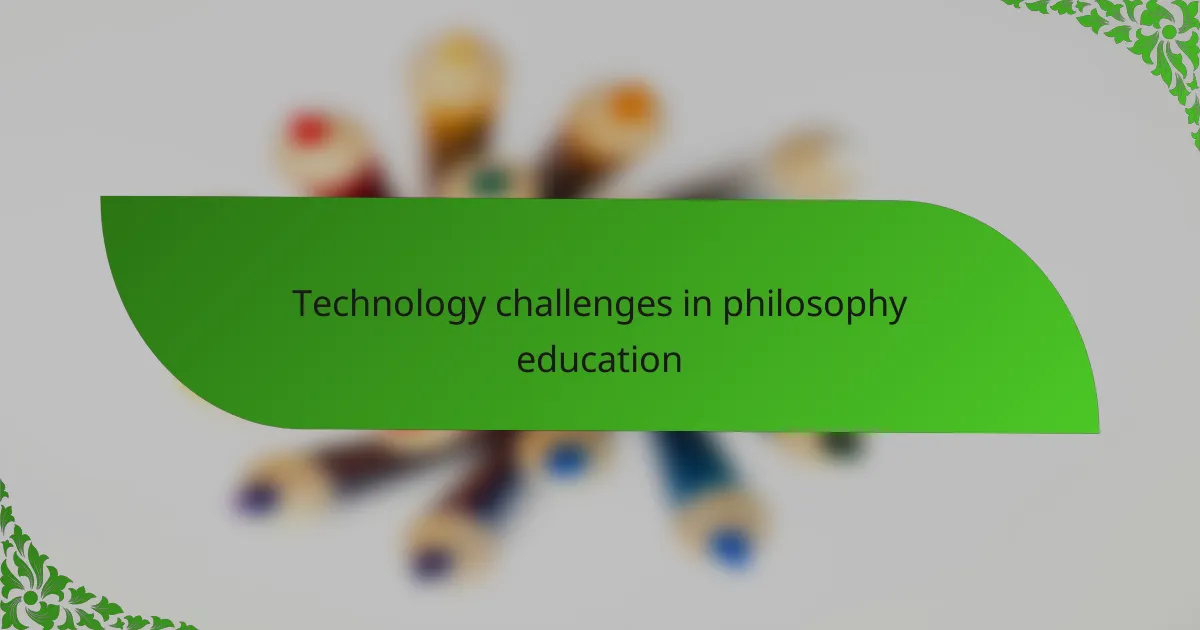
Technology challenges in philosophy education
Technology poses unique challenges in philosophy education that I’ve grappled with myself. For one, the reliance on screens can sometimes fragment attention, making it harder to sustain the deep, contemplative focus that philosophy demands. Have you ever noticed your mind drifting during an online lecture, craving the immersive presence of a live debate?
I’ve also found that digital discussions occasionally lack the nuanced body language and tone that enrich face-to-face philosophical exchanges. This absence can lead to misunderstandings or a sense of detachment, which feels like losing a vital layer of communication. Does that make you wonder if some aspects of human interaction resist full translation into the virtual world?
Moreover, technology encourages a speed and volume of information that can overwhelm rather than enlighten. I recall moments when scrolling through endless articles and posts left me more confused than inspired, questioning if the depth of philosophical reflection can survive in a culture of quick clicks and short attention spans. How do we balance accessibility with meaningful engagement in this fast-paced digital age?
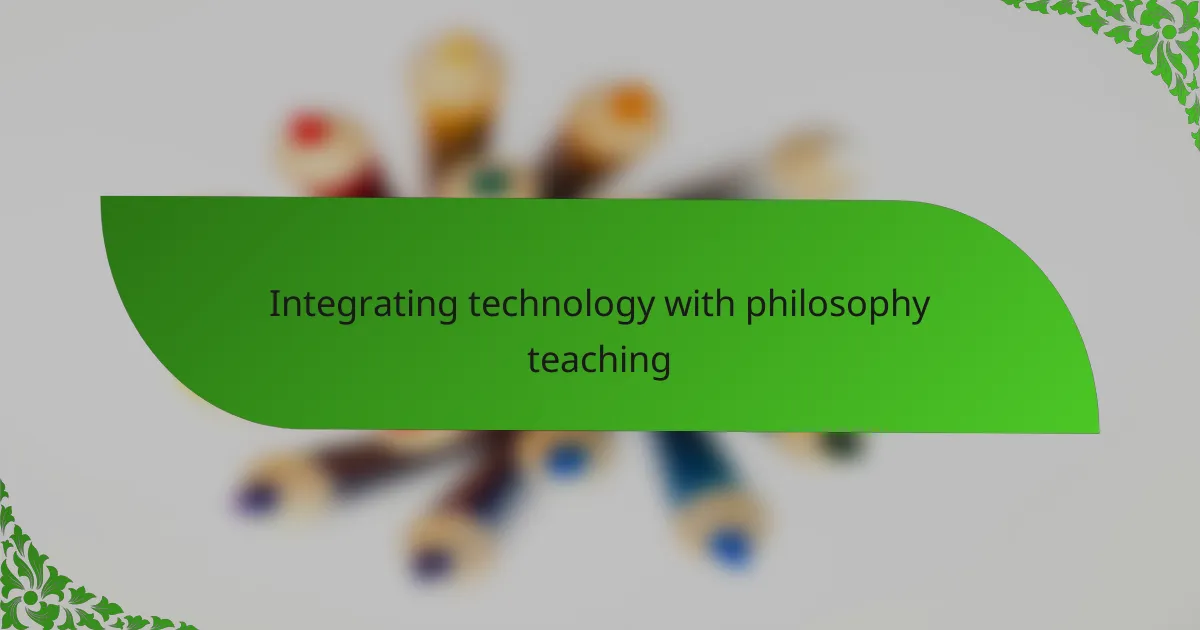
Integrating technology with philosophy teaching
Integrating technology with philosophy teaching has often felt like walking a tightrope to me. I remember trying out virtual reality simulations that placed me inside famous philosophical thought experiments; the immersion was thrilling, but I wondered if this sensory overload might overshadow the subtlety of critical thinking. Have you ever found that too much technology sometimes drowns the quiet pondering philosophy requires?
On the other hand, I’ve seen digital platforms foster lively debates that extend well beyond the classroom walls. When students engage through online forums, they bring in diverse perspectives that enliven traditional discussions, making philosophy feel more connected to real-world issues. It made me think: can technology help philosophy break free from its sometimes insular reputation?
Still, balancing screen time with face-to-face dialogue remains a delicate act. I often encourage my students to use tech tools as a starting point—like accessing texts or sparking conversations—but then return to personal reflection and group debates to deepen understanding. Doesn’t this blend of old and new teaching methods enrich the learning experience, rather than replace it?
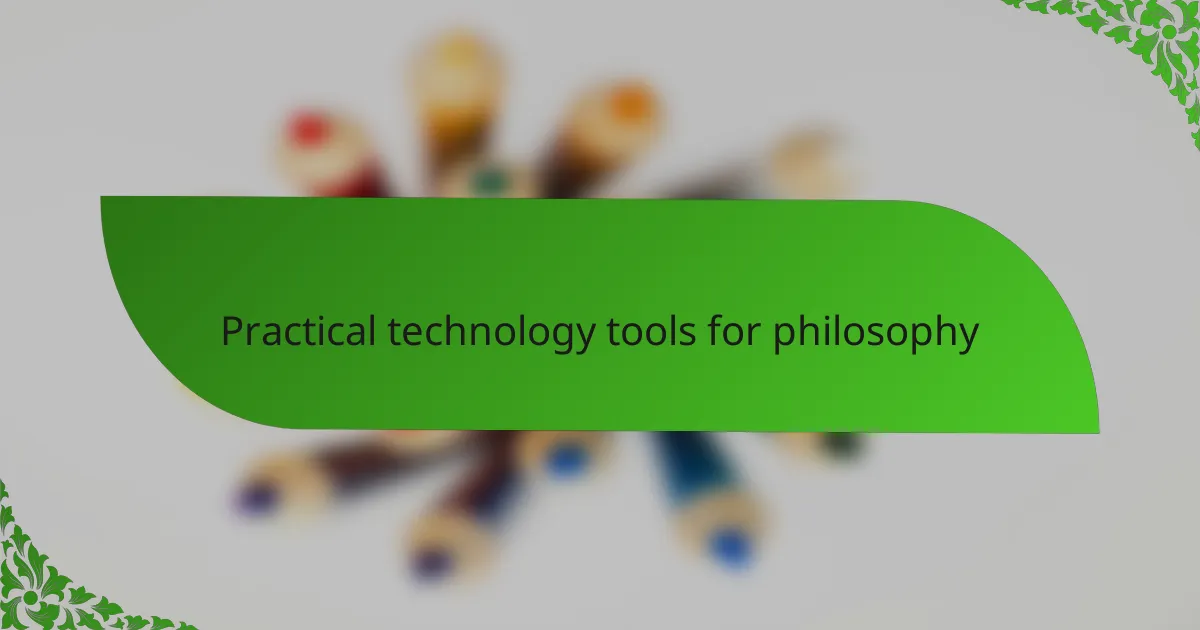
Practical technology tools for philosophy
When I first experimented with mind-mapping software in my philosophy sessions, I was surprised by how it helped me visually organize complex arguments. It felt like drawing a roadmap through dense ideas, making connections clearer and debates more structured. Have you tried mapping out a philosophical concept and suddenly discovered new relationships you hadn’t noticed before?
Digital annotation tools have also become a quiet companion for me during readings. Highlighting passages and jotting down reactions right next to a text transforms solitary reading into an interactive conversation with the author. Sometimes, I wonder if this way of engaging deepens understanding more than traditional note-taking ever could.
Then there are collaborative platforms where students share essays and comment on each other’s reasoning in real time. I’ve witnessed firsthand how immediate feedback sparks richer discussions and encourages careful revision. Doesn’t that immediacy create a sense of community and shared intellectual curiosity that’s hard to replicate otherwise?
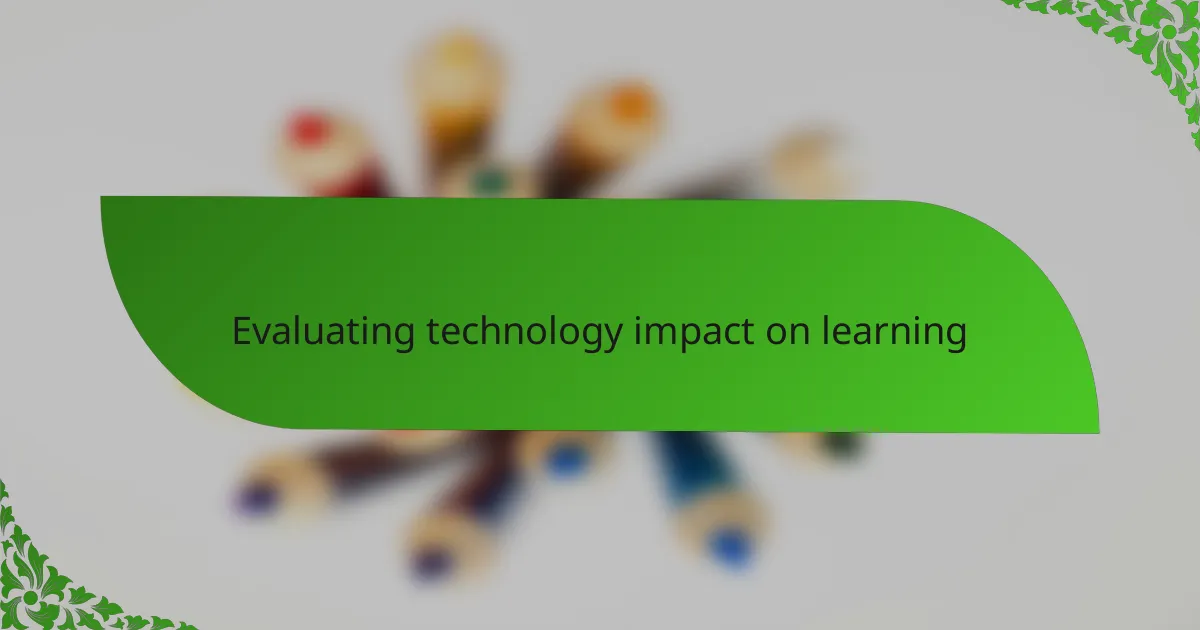
Evaluating technology impact on learning
Evaluating the impact of technology on learning often feels like trying to measure the invisible. I’ve caught myself wondering whether the convenience of instantly accessible information truly translates into deeper understanding, or if it sometimes encourages surface-level engagement. Have you experienced moments when an abundance of resources felt more like noise than clarity?
From my perspective, technology’s real effect depends heavily on how thoughtfully it’s integrated. When I’ve used digital tools to complement traditional discussions—not replace them—I’ve noticed a richer, more layered learning experience emerge. It’s like adding a new instrument to an orchestra: the composition can become more vibrant, but only if it harmonizes with the existing melodies.
However, I remain cautious about assuming that technology inherently improves learning outcomes. In my experience, meaningful reflection and critical thinking—the heart of philosophy—require spaces free from distraction. Can technology create these spaces, or does it always risk pulling attention in too many directions? This balance is what I find most challenging to evaluate.
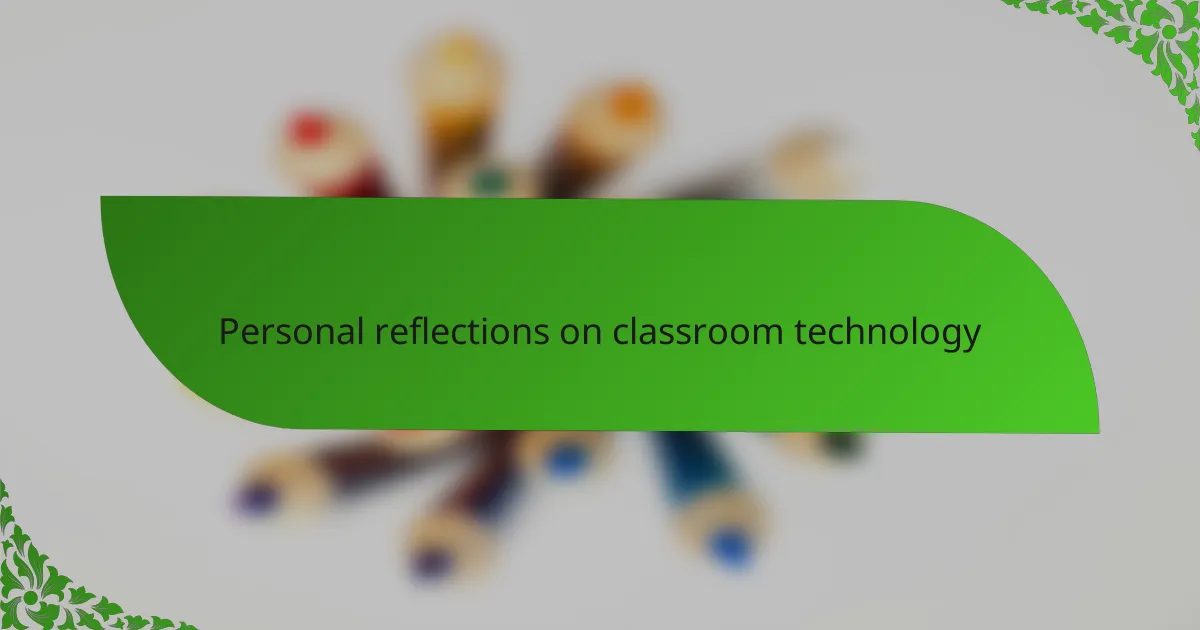
Personal reflections on classroom technology
When I think back on how technology has shaped my classroom experiences, I recall feeling a mix of excitement and hesitation. There were moments when a well-timed digital resource sparked a fresh insight, yet other times I missed the raw, unfiltered energy of face-to-face exchanges. Have you ever felt torn between the immediacy of a screen and the depth of a live discussion?
Sometimes, I’ve noticed technology acting like a double-edged sword—opening doors to endless information but also tempting my focus away from sustained, reflective thought. It’s as if the screen invites me to skim surfaces rather than dive deep, which feels at odds with philosophy’s demand for careful contemplation. How do we resist this pull without rejecting the tools altogether?
Still, I can’t deny the thrill when technology enriches the learning space—like when collaborative platforms reveal unexpected perspectives that would be hard to catch in a traditional setting. Those moments remind me that, with intention, technology doesn’t replace philosophical dialogue; it amplifies it in ways I hadn’t imagined. Could this be the future of philosophical inquiry, blending human insight with digital reach?